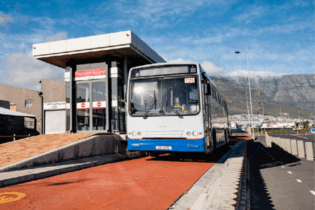This superbly engineered project places Transnet Freight Rail at the forefront of technology deployment in a strategic and operationally critical installation. John Batwell takes a look.
Forty or so years back, one would have expected to see Transnet Freight Rail’s (TFR’s) semi-circular shaped, multi-terraced, 24/7 operational control centre on a black and white, futuristic television episode of Star Trek! Just over three years ago, the imposing, open-plan National Command Centre (NCC) in Transnet’s Parktown office block started up – an ‘umbilical cord’ in so many facets of a well-greased, integrated railway operation. Following TFR’s CEO Siyabonga Gama’s visit to the United States last decade, the local R90 million NCC launched on 4 August 2008 is based on the observations gleaned from Burlington Northern and Union Pacific. From a seamless managerial point of view, the control centre has incorporated into one physical complex the planning, operational execution and day-to-day troubleshooting of four principal, geographically oriented corridors – the Cape, Central, KwaZulu-Natal and Eastern regions. These comprise altogether 8 441 km of electrified railway and 11 606 km of non-electrified routing. The hardware running along any of these four management corridors consists of 813 diesel locomotives, 1 161 electric units and 115 types of wagons. Each ‘corridor team’ of designated personnel is responsible for: • service Planning• an Integrated Train Plan
• a Monitoring and Deviation Plan
• the provision of appropriate types of motive power and rolling stock
• locomotive distribution
• availability of infrastructure
• customer care
• security on the ground. There are teams of personnel who run with the quirks, characteristics and specific rail transportation profile of their individual corridors. Pre-planning and budgeting in terms of the profile of product movement in these corridors is executed well in advance. In late August, the 2012/13 business plan was almost in situ. The budgeting process running in Transnet’s financial year of April to March embraces firm rail orders from customers, which are reviewed quarterly within the particular financial year, hand in hand with the prospective motive power, wagons and crews required to fulfil customers’ tonnage expectations. This dovetails down to the customers with their weekly orders. The customer service managers look at the variable permutations within this operational component alone. In terms of new weekly business, a weekly planning meeting is run – an Integrated Train Plan (ITP) covers the entire country and focuses on issues such as empty wagons’ distribution, types of wagons required, line occupation management and locomotive maintenance, with resultant availability versus non-availability of relevant motive power. Multiple freight offerings
There are varied types of freight services offered: MegaRail, made up of block load trains (all one commodity) on fixed days and times; FlexiRail, which, as the name suggests, is ‘flexible’ for things such as seasonal rail traffic; and AccessRail, which is dictated by specific days and times. When it comes to major railway maintenance occupation such as the servicing of the coal and iron ore corridors and Natcor (the Johannesburg-Durban high-volume line), this is built into train movement planning a good 12 months or even longer in advance. Other planned occupations of a particular rail section are in place 21 days ahead of the particular week’s traffic being analysed for such a route. The regional operational executives (ROEs) pull up the ITP for their region to view the holistic situation particular to their rail sector.
Meeting customers’ needs
A typical operational week at the NCC consists of seeing what new weekly business is at hand by 12 noon on a Wednesday. Two hours later, at 14:00, a ‘pre do-ability’ exercise is underway to determine the ability to meet the customer’s transportation request and by Thursday morning at 11:00, the ‘do-ability’ has been determined. Twenty-five hours later, on a Friday at midday, the ITP is signed off.
All in all, one comes away reflecting that TFR’s hub in Parktown is certainly impressive, manned by passionate, professional staff who are overtly passionate about what they contribute to the efficacy of the centre and its round-the-clock function nationally. Senior management seeks to achieve safely 219 million tonnes in the 2011/12 financial year – general freight business 89 mt, export coal 74 mt and export iron ore 56 mt. This desire represents at least a 17% increase in volumes from the previous financial year. Staff members were noticed wearing motivational ‘219 Safely’ printed T-shirts! Seeing the NCC first-hand did, however, trigger a most daunting thought: in the light of pressure on government to separate TFR into infrastructure on one side and allow private operators onto TFR’s lines on the other, one does wonder what a huge challenge – a nightmarish paradigm shift – would be imposed on the management and staff of this very specialised, well-honed in-house ‘railway nerve centre’.







